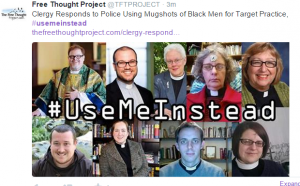
Clergy have been posting pictures of themselves to Twitter with the provocative hashtag, #usemeinstead. Over the weekend, the Washington Post picked up the story.
The idea originated on a closed Facebook group for Lutheran clergy, where pastors were discussing how North Miami Beach’s police department had been caught using mugshots of actual people for target practice. Let’s send in our own photos for target practice, the pastors decided.
The target-practice story had come to light after National Guard Sgt. Valerie Deant saw bullet-riddled mugshots of black men at a police gun range. One photo was of Deant’s brother. Outrage followed in North Miami Beach and beyond as critics called for the police chief’s resignation.
Clergy across the country got involved in the effort.
“We initially started thinking if a whole lot of us, in our clergy collar and worship attire, sent our photos to them, it would make a really powerful statement,” Rev. Kris Totzke, a pastor in Texas, told The Post. “Then, it really snowballed, and we got people all over the country and of all different faiths.”
The images of pastors, monks and others wearing clothing that in part symbolizes peace and love are intended to be striking, to cause people pulling the trigger to think twice.
“It’s such a desensitization thing, that if you start aiming at young black men, and told to put a bullet in them, you become desensitized,” Gonnerman said. “Maybe, to change the picture, it’s you know what, dare ya, shoot a clergy person.”
A selection of the tweeted pictures is offered on the Post website, which also notes that using mugshots for target practice has now been banned and apologies issued by city officials and the police.
But yesterday, the Huffington Post reported that the reaction to the story is not all positive.
It wasn’t long before Broderick Greer, a 24-year-old student at Virginia Theological Seminary, noticed something about the pictures showing up under #UseMeInstead.
Most of the participants were white.
“I’m conflicted. I have so many wonderful white clergy friends involved in that hashtag,” Greer told HuffPost. “But it’s fallen into a ‘white savior’ narrative, that these white clergy have come to the aid of these helpless black people. And I don’t think that’s what we’re trying to promote.
“We don’t want white people to be used instead of black people as a target, we don’t want anyone to be used as target practice,” Greer continued. “We want everyone to live in a society where they’re not targeted for anything.”
The Revd Joy M. Gonnerman, part of the originating group, responded.
“These young men [the police] were shooting at were black, but this was a reminder that they are human people, regardless of race,” Gonnerman told HuffPost about #UseMeInstead. “I understand the sentiment of the ‘white savior’ thing, but it doesn’t mean we should stand aside and say we have nothing to do at all.”
The Revd Angela Shannon, also a member of the facebook group of Lutheran pastors that started the trend, hopes that this might turn into a learning experience.
If anything, the episode was a teaching opportunity, Shannon said. It was a moment to step back and think about what it means to be a supportive ally, without becoming the hero of the story.
The Rev. Lura N. Groen, one of the administrators of the Facebook event, said pastors of color need to have their voices elevated in the discussion.
“I’m happy so many Lutheran pastors were motivated to jump into the conversation about race, which we’ve been far too silent on,” Groen wrote on Facebook. “But I hope we keep learning how to do it more responsibly, be better allies.”
Read more here. Have you seen the hashtag? Did you participate? What do you think about #usemeinstead?
UPDATE from our comments:
Victoria Weinstein (aka Peace Bang) writes of her dismay at this campaign. In the comments, Wil Gafney, well known author and theologian, replies:
“I (as an African American) and the black pastor who co-started this movement in conversation with her white colleagues disagree with the way the project has been characterized here and elsewhere. It’s been interesting to watch what was a joint effort of black and white clergy allies become a white people’s project. As the meme-ing distorted the project its founders relinquished it. It did not start as a white savior project. We had a twitter conversation with Broderick and another African American scholar about our difference of opinion and one side of that conversation became “the” black response. I respect Broderick and others who are troubled by it, especially what it became. But the entire affair and the role of many pastors who I knew personally and quite frankly educated is not that simple. There were layers to this beyond the superficial one that took over twitter.”
Posted by Rosalind Hughes
